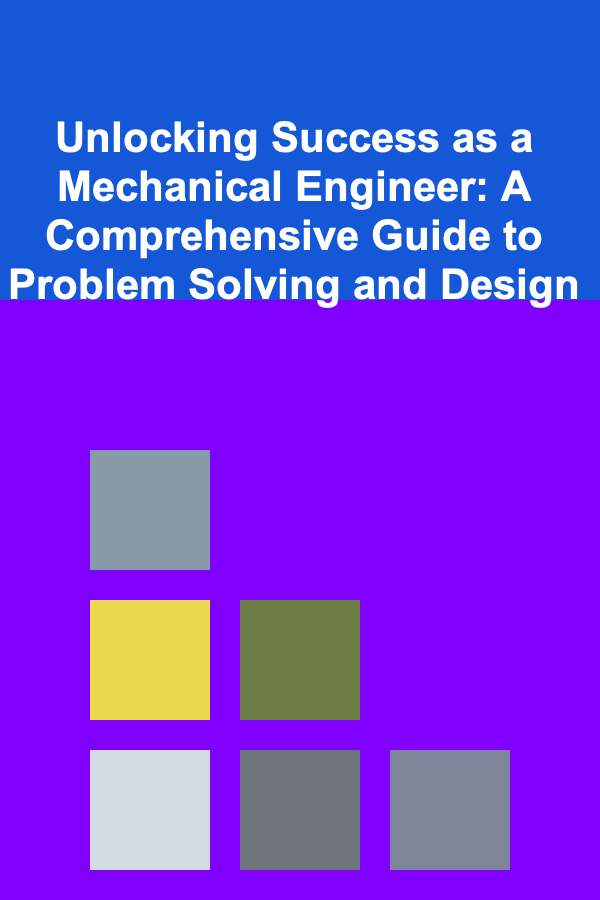
Unlocking Success as a Mechanical Engineer: A Comprehensive Guide to Problem Solving and Design
ebook include PDF & Audio bundle (Micro Guide)
$12.99$5.99
Limited Time Offer! Order within the next:

Mechanical engineering is a broad and dynamic field that demands a unique combination of technical expertise, creativity, and problem-solving skills. Whether you're designing innovative machinery, optimizing systems, or tackling complex challenges, the path to success as a mechanical engineer requires continuous learning and adaptation. In this comprehensive guide, we'll explore the essential principles, techniques, and strategies that can help unlock success in your mechanical engineering career. This guide is tailored to help engineers at all levels, from fresh graduates to seasoned professionals, sharpen their skills and approach problem-solving and design with confidence.
The Core Principles of Mechanical Engineering
Before delving into problem-solving and design strategies, it's crucial to understand the foundational principles of mechanical engineering. These principles will guide your approach to any engineering challenge you face.
1. Understanding Mechanics and Materials
At the heart of mechanical engineering is an understanding of how materials behave under various forces. Whether it's tensile strength, thermal properties, or fatigue resistance, understanding the properties of materials and how they respond to stress is key.
- Statics and Dynamics: Statics deals with forces on stationary bodies, while dynamics looks at forces and motion in systems. Both areas are critical for designing stable structures and understanding system behaviors.
- Material Science: Mechanical engineers must understand the properties of metals, polymers, ceramics, and composites. A deep knowledge of how materials react under different conditions can help in selecting the right materials for a given application.
- Thermodynamics: Thermodynamics deals with energy and heat flow. It's essential for understanding power generation, refrigeration cycles, and fluid dynamics in mechanical systems.
2. Problem-Solving Mindset
Being an effective problem solver is one of the most important skills a mechanical engineer can develop. The ability to break down complex challenges into smaller, manageable parts is essential.
The steps to effective problem-solving typically follow this process:
- Define the Problem Clearly: Understanding the problem's parameters is critical. Identify the scope, constraints, and the desired outcome.
- Gather Data and Information: Collect all relevant data such as materials properties, environmental conditions, and operational constraints.
- Develop Multiple Solutions: Don't settle for the first solution you come up with. Brainstorm different approaches to the problem.
- Analyze and Evaluate Solutions: Use mathematical models, simulations, and real-world testing to assess the effectiveness of each solution.
- Implement and Test: Once you select a solution, implement it in a prototype or pilot version and test it in real-world conditions.
Mastering the Design Process
Mechanical engineers are often tasked with designing systems, components, or products. A successful design process goes far beyond creating a blueprint; it involves understanding user needs, material properties, manufacturing constraints, and more. Here are key elements of the design process:
1. Conceptual Design
The conceptual design phase focuses on generating ideas and outlining the broad parameters of a solution. During this phase, creativity is essential. Engineers brainstorm various potential solutions without worrying about the specific details just yet.
Key Concepts in Conceptual Design:
- Ideation and Brainstorming: Use brainstorming techniques, such as mind mapping, to explore a range of ideas. Tools like TRIZ (Theory of Inventive Problem Solving) can also be used to guide inventive thinking.
- Design Constraints: Consider budget, material availability, environmental impact, and manufacturing processes that might limit your design.
- Feasibility Studies: Perform early-stage analysis to gauge the feasibility of the design concept. This includes assessing the potential risks and the most likely solutions to meet requirements.
2. Preliminary Design
In the preliminary design stage, engineers develop the initial versions of their ideas. This stage focuses on defining the general layout of components, systems, and interactions.
Key Concepts in Preliminary Design:
- Prototyping and Sketching: Create rough models or digital prototypes of the design to visualize and evaluate the feasibility of each element.
- Simulation and Modeling: Use software such as SolidWorks, AutoCAD, or CATIA to simulate how the components will interact and function in real-world conditions.
- Design Iteration: Constantly refine the design through multiple iterations, addressing any issues that arise during simulations or prototype testing.
3. Detailed Design
The detailed design phase is where the technical specifics are finalized. It's a critical step that involves determining exact measurements, materials, and manufacturing processes.
Key Concepts in Detailed Design:
- Finite Element Analysis (FEA): Use FEA software to analyze the mechanical behavior of the design under various conditions, ensuring strength, durability, and safety.
- CAD and CAM Integration: Advanced CAD software helps in creating detailed drawings, while CAM (Computer-Aided Manufacturing) software ensures that the design can be manufactured efficiently.
- Material Selection: Carefully choose materials based on strength, weight, durability, and cost, while ensuring that they meet the design's performance requirements.
4. Prototyping and Testing
Testing the design is one of the most important steps to validate its performance and ensure that it meets all specified requirements.
Key Concepts in Prototyping and Testing:
- Build a Prototype: Once the design is finalized, build a physical prototype (or use rapid prototyping methods like 3D printing) to test how it functions in the real world.
- Iterative Testing: Conduct rigorous testing and data collection on the prototype. Use this data to iterate and improve the design further.
- Performance Evaluation: Test the product under real-world conditions to evaluate its efficiency, reliability, and safety.
5. Manufacturing and Production
The final phase of the design process is preparing for large-scale manufacturing. Engineers must ensure that the design can be reproduced consistently and cost-effectively while meeting quality standards.
Key Concepts in Manufacturing:
- Design for Manufacturability (DFM): Focus on designing products that are easy and cost-effective to manufacture.
- Supply Chain Management: Work closely with suppliers and manufacturers to select components and materials that will streamline production while maintaining quality standards.
- Quality Control: Implement testing procedures, inspections, and continuous quality control measures throughout the production process.
Advanced Problem-Solving Techniques for Mechanical Engineers
In addition to traditional problem-solving methods, mechanical engineers can benefit from a range of advanced techniques to enhance their ability to solve complex problems.
1. Root Cause Analysis (RCA)
Root Cause Analysis is a method used to identify the fundamental cause of a problem, rather than just addressing its symptoms. By addressing the root cause, engineers can prevent recurrence and design long-term solutions.
2. Lean Engineering Principles
Lean engineering focuses on maximizing value by minimizing waste. In a mechanical engineering context, this could mean reducing unnecessary steps in the design process or finding ways to streamline manufacturing and assembly processes.
3. Six Sigma
Six Sigma is a data-driven methodology used to improve the quality of processes by identifying and eliminating defects. In mechanical engineering, Six Sigma can be applied to design optimization, quality control, and product reliability.
4. Systems Thinking
Systems thinking involves understanding the interrelationships between the components of a system rather than focusing on individual parts. This holistic approach can help mechanical engineers anticipate issues and improve the performance of complex systems.
Building a Successful Career in Mechanical Engineering
Being a successful mechanical engineer doesn't just depend on technical skills; it also involves continuous professional development and effective communication.
1. Continuous Learning and Innovation
Mechanical engineering is an ever-evolving field, with new technologies and techniques emerging regularly. Stay on top of industry trends by attending conferences, reading academic journals, and pursuing certifications in specialized areas such as robotics, additive manufacturing, or energy systems.
2. Collaboration and Communication
Effective collaboration with colleagues from other disciplines, such as electrical engineers, civil engineers, or designers, is key to success. Moreover, communication skills---both written and verbal---are essential for presenting ideas, explaining designs, and documenting processes.
3. Mentorship and Networking
Seek mentorship from experienced professionals who can provide guidance and share their insights. Networking with other engineers and professionals in related fields can also open up career opportunities and foster collaborative efforts on projects.
Conclusion
Mechanical engineering is a challenging yet rewarding career that offers endless opportunities for innovation and problem-solving. By mastering the fundamental principles of mechanics, honing your problem-solving skills, and applying systematic approaches to design, you can unlock success in this dynamic field. Continuous learning, adaptability, and collaboration are all crucial to navigating the ever-changing landscape of mechanical engineering and ensuring that your designs make a lasting impact.

How to Convert Your Home into a Vacation Rental Property
Read More
How to Design a Party Supplies Checklist for Office Parties
Read More
How To Master Cleaning Your Pet's Ears
Read More
How to Cook Healthy Grill and BBQ Recipes for Weight Loss
Read More
How To Create Professional Presentations (Design Focus)
Read More
Developing Hyperloop Transportation Systems: A Deep Dive
Read MoreOther Products

How to Convert Your Home into a Vacation Rental Property
Read More
How to Design a Party Supplies Checklist for Office Parties
Read More
How To Master Cleaning Your Pet's Ears
Read More
How to Cook Healthy Grill and BBQ Recipes for Weight Loss
Read More
How To Create Professional Presentations (Design Focus)
Read More